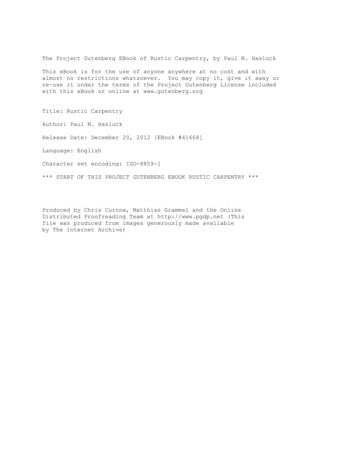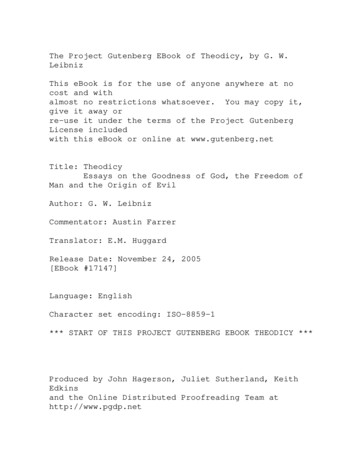
Transcription
The Basics Revealed, 2019eBook on Data Center ManagementCorrelata SolutionsOfer Laksman, President
Data Center Infrastructure Management (DCIM) is the overall discipline of managingthe physical and virtual infrastructure systems of a data center operations, as well asoptimizing its ongoing operation. DCIM is a software suite that bridges the gapbetween IT and the facilities groups and coordinates between the two. One of themain topics of DCIM was to reduce computing costs while making it easier to quicklysupport new applications and other business requirements.This eBook, authored by Ofer Laksman, chief executive officer and co-founder,Correlata, explains the importance of the new DCIM in its relationships to data centermanagement and the business needs, describing the key components of a modernDCIM system, guiding you in the selection of the right DCIM solution for your particularneeds, and provides a step-by-step formula for a successful DCIM implementation.Because this is an eBook focusing on the Basics for Data Center Management, youcan be assured that it’s easy to read and has simple tips throughout.You can find more information about data center solutions by visiting the followingwebsite: www.Correlata.com.As I prepared this eBook, I assume a few things about you and your situation:You’re responsible for a data center, and understanding its intricacies isbecoming increasingly difficult.You’re a C-level executive and your data center is of strategic and fiscalimportance to your organization.You’re curious about how the operation of an enterprise-level data centercan be optimized today.
PART ONEAn examination of today’s data centersStakeholders of DCIMThe overview DCM goalsLooking closely at DCIMCan IT align IT with the business?Try saying Data Center Infrastructure Management ten times fast.Now you know why everybody calls it DCIM instead.It’s a complex subject, and DCIM means different things to different people. Basically though,DCIM is a resource and capacity planning business management solution for the datacenter. DCIM as a separate field came into being in response to changes in the operatingenvironment that required better management of operations that had been ad-hoc in thepast.Part One of Two explains how data centers have evolved and how they were haphazardlymanaged before comprehensive, integrated DCIM software became available. It alsodiscusses how the demand for ever-increasing performance and need for scalability of anygiven data center has driven the evolution of increasingly powerful new set of solutions tohelp manage all the infrastructure a data center needs, including hardware, software,facilities resources, linked to the business needsHow Data Centers Have EvolvedEver since computers were first used for business tasks, the specific needs of each applicationin aggregate have dictated the size, capacity, and specific configuration of the computingenvironment. As businesses grow and the number of computing increases, their data centerneeds grow and evolve as well. Because challenges and opportunities can differ from onebusiness to another, the computing resources of each tend to evolve in different ways.
To meet these different application needs, the data center is constantly changing, even ourconcept of a data center is changing. Equipment is added or removed regularly. Olderequipment is exchanged for newer, more powerful or more cost-effective machines.Decisions are made that hybridize our compute infrastructure. What applications andcompute resources live in the dedicated data center, when is a colocation facility practical,what compute resources are moved to or from the cloud? At times, data center changecan be sweeping and disruptive.After a few years of ad-hoc changes combined with normal employee turnover, nobodyknows exactly what equipment exists, why or where it is installed, who owns it, or even whatit does. Old technology performs poorly and has a higher rate of failure. Zombie servers sitidle yet consume power, real estate, and unnecessary support expense, yet no one is willingto assume the risk to de-commission those installed systemsData centers that have grown haphazardly as requirements have shifted have often becomemassive structures that are difficult to support, operate, and manage. All too often, band-aidfixes to problems are applied that fix problems for a short time, but leave untouched theunderlying structural and ongoing management problems.What Does It Provide?Many enterprise-level organizations have large,integrated software suites that oversee and managekey aspects of their business, such as sales, finance,manufacturing, and shipping.The larger the organization, the more critical it isto have such overarching visibility and controlover core concerns.The same logic calls for comprehensive,integrated control over the enterprise’sphysical compute infrastructure linkedto the business objectives, which hastypically become an organization’slargest and most valuable asset.
The desire is to move from a tactical approach aimed at keeping some bad things fromhappening to a strategic implementation of well-organized management technology.The aim is to capture years of data center asset-management expertise and present it assets of business management processes and specific supporting tools. The result is effectiveongoing management of the business at hand, which is definable, accountable, defendable,supportable, and consistent.In simple terms, the new DCIM, best categorized as Cognitive Analytics Operations (CAO) isthe strategic business management solution for the future of data center operations. COAis the structured approach to managing change, purpose-built for the modern computeinfrastructure. That change consists of the facility itself, as well as all of the IT componentshoused within those facilities, colocation, and edge compute locations.Perhaps more than anything else, CAO’s value is in its capability to manage change workflows for the business of IT at the infrastructure level and in tying these structures to theapplications that live on top of that infrastructure.In the course of its evolution, DCIM has become a data center management extension toa number of other systems, including asset and service management, financial generalledgers, and other core business systems. A well-deployed DCIM solution quantifies thecosts associated with moving, adding, or changing equipment on the data center floor. Itunderstands the cost and complexity of operation of those assets, and clearly identifiesthe value that each asset provides over its lifespan. The views provided by DCIM serve tobring together the IT and the facilities world.The physical assets of the facility, such as floor space, electrical power, environmental control,and cooling are monitored and controlled yet by traditional DCIM processes, which theninterface with the virtual infrastructure overseen by the IT function. The DCIM suite providesan overview of system health and functioning, and also enables drilling down to any desiredlevel of detail for fine-grained control of operations.As a category, DCIM can be pretty broadly and loosely defined. A well-conceived DCIMimplementation will generally include several such vendor solutions, all working together.For example, a core DCIM management suite might be coupled with intelligent powerappliances as well as several different environment sensor solutions. The most advancedDCIM solutions aggregate all of the numerous data points, eliminate multiple tools providinga single view and one source of truth across the entire compute infrastructure.
Of all the advantages that DCIM provides, perhaps the most important is that it breaks downthe walls of the silos that IT and facilities have been living in and enables those groups towork together more closely to satisfy the needs of the business. The overall goals are toreduce the cost of doing the computing work that the data center is charged with doing andincrease the responsiveness to changing business needs.Computing cost has many components. Some are IT-specific, some are facilities-specific,and some relate to the interface between the two. Prior to the implementation of a DCIMsystem, some of those interface opportunity costs can’t be realized because they don’tleverage the broader view. The DCIM platform exposes these costs and allows scrutiny,which is the first step toward reducing or eliminating them.Are the IT aspects of CAO Cognitive Analytics important?The IT aspects of DCIM are primarily concerned with resource and process management.Do you have enough space and power in the right place for new application rollout? Are theprovisioning, remediation, and decommissioning workflows the correct ones? Are theseprocesses repeatable and defend-able? These are the main questions that IT managers areasking, and they’re looking to DCIM for the answers. Today’s CAOsuites should be able togive answers to these questions with an easy-to-comprehend visual representation of thestate of the system at any point in time.What are the most important facilities aspects of CAO?To the facilities manager and leading management, visibility and transparency of the entiredata center operations usage and effectiveness link to the business objectives is important,looking beyond just the systems, deployment, network, re-use and consolidation of companies tooling and their silo approach, as is the capability to manage capacity-related planningand what-if scenarios which can address some aspects of their internal skills gap. as well.Job one is to provide an environment that enables continuing, trouble-free operation. Thismust also be accompanied by a clear understanding of the impact of new projects on relatedresources.
CAO Analytics relates to the overall business goalsIT and facilities management must constantly maintain a delicate balancing act to matchthe supply of computing with the ever-changing demand for it. A major business goal is toprovide needed computing services at the lowest possible cost per unit of work. To do that,organizations must maintain sufficient capacity to satisfy peak demand, but at the sametime they must have the knowledge that will enable them to plan for future computingneeds over time. A comprehensive CAO system can provide a critical set of new metrics tobe used to perform the matching operation between computing supply and businessdemand automatically, with-out human intervention.Is CAO Important?CAO enables the data center to make the best use of the data center resources available,as well as enabling the seamless integration of the data center into the enterprise’s otherbusiness management solutions for asset management, process management, computecapacity and usage, data management, energy management, capacity planning,budgetary planning, and other important systems. Information is the most strategic assetand competitive differentiator that an organization has.The data center systems are the producer of that strategic value. CAO is the premiermanager platform of that data, consisting potentially of hundreds of millions of dollarsin assets, as well as billions of dollars in information that flows through the computeinfrastructure.Who are the CAO Stakeholders?1The first, of course, is the IT organization, which consists of individualswho spend their entire careers keeping data center systems operating.2A close second is the facilities organization, which must supply powerand cooling as well as maintain building infrastructure, in support ofdata center operations.3Thirdly, the finance department is focused on the costs of maintainingthe data center infra-structure, and how those costs compare with thebusiness value delivered by the data center.4Fourth, the executive team must understand the positive impact CAOcan have on their corporate management tasks, especially in regard totoday’s increased focus on IT costs.
CAO Influences, Enables, and Supports Corporate Goals for IT – or does it?Information technology has been in a state of continual transition since its beginnings.These changes, in a multitude of areas, can be smoother and less painful with CAO.Here are some of the benefits of CAO:The ascendancy of the cloud has had a major disruptive effect on the traditional way ofscaling business processing. CAO can be used with both public and private cloud makingit easier to create IT infrastructures that are more elastic and responsive. CAO provides theability to make decisions on what applications to send to the cloud, what applications toleverage it for DR, and, more recently, what applications to repatriate back into the physicalworld. It delivers high degrees of visibility and control of space, power, and networkingresources.By actively managing assets, which in turn affects total power usage, CAO can have asignificant impact on an organization’s cost structure and carbon footprint. CAO allowsenergy usage to be modelled upfront instead of tracked after the fact.To optimally deploy assets within a data center, and across the entire physical computeinfrastructure, detailed capacity planning is essential. CAO provides the detail identifyingwhere each asset should be deployed and how frequently equipment should be refreshed.CAO gives managers visibility of long-term usage trends.In the past, IT organizations have acted reactively to problems as they arose. But CAO, bymaking fine-grained information available instantly, can enhance and coordinate changesacross major systems. Users CAOsystems can dramatically increase operational efficiency,increase productivity, reduce human errors, and even reduce the time it takes to solveproblems that do arise. As a result, rather than requiring a large number of low-skilledworkers who perform repetitive jobs or signing massive service agreements with serviceproviders, organizations with CAO in place can utilize those workers in higher-skilled roles.The facilities that house a data center are costly, and CAO extends the useful life of thosedata centers by identifying stranded resources, such as zombie and ghost servers, and byoptimizing the use of existing capacity. Any time you can avoid buying new capacity bymaking better use of the capacity you already have is a win for your organization.
Common Goals for CAOPeople with different functions come to CAO with different goals, based on different needsthat they have. Fortunately, DCIM actually can help with widely disparate requirements,including the following:One overriding goal is to reduce the operating cost of the data center. It is a truism that youcan’t manage what you don’t measure. The instantaneous view that CAO gives you of notonly operations efficiency, but also every other critical resource gives you the basis forperforming actions that will lower costs and continue to control them on an ongoing basis.In addition to optimizing data center operations, a major goal of CAO is to provide timely andaccurate information about the available capacity of the data center for future growth andthe making sure that the data center operations is aligned with the business objectives, policyand compliance. If you want a data center to operate according to best practices, it’simportant to be able to identify, optimize, and manage the workflows associated withchange for the data center’s physical assets.CAO coordinates and consolidates disparate sources of real-timeinformation into a single view of asset knowledge, facilities,and compute infrastructure.CAO gives predictability of space, power, and cooling capacity,increasing data center lifespans as well as loweringoperating costs.CAO translates raw data about the data center intoactionable business intelligence suitable for all.
CAO should touch every aspect of the operation across the physical compute infrastructureto provide value in a number of different ways.Some of these ways have to do with controlling costs, some facilitate smoother and moresupportable operations, and others make it easier to operate in compliance with governmentregulations.Is CAO Important TodayCAO is a relatively new discipline, but of course organizations have been concerned withasset management since the first data centers started operating. Early approaches to datacenter asset management were merely extensions of financial bookkeeping tools.Accounting systems were augmented by adding information about physical attributes ofassets and who owned what. Some efforts went beyond that to include crude visualizationsof rack and floor layouts. These early efforts added some value to the enterprise, but werenot considered strategic, so they didn’t improve much with time. They were consideredtactical tools and not critical.Everything changed when the financial crisis of 2007-2008 turned into The Great Recessionof sorts. The price of energy skyrocketed, while the income streams for many organizationsplummeted. Reduced customer spending caused the data center industry to look for waysto become more efficient. Luckily, some of the DCIM solutions at that time had risen to alevel of maturity to answer those needs.The three physical resources that have the biggest impact on data center cost are power,cooling, and floor space. The cost of power has been rising steadily, and as consumptionincreases, the need for more cooling capacity increases right along with it. In addition torequiring more power and cooling capacity, floor space in the data center must be treatedas a precious commodity because it is finite in nature.The cost to add space to the infrastructure is enormous. High quality space is actually hardto come by. Power is available in most locations, but at a cost that continues to rise. Andremember that for every watt of power that is used by IT equipment, another watt of poweris used to cool that equipment.The analytics functions of DCIM installations show where and how these physical resourcesare used and predict future needs based on existing trends.
The massive amount of data being collected and processed now will only get larger. CAOenables the quantification of current data center capacity and the entire hybrid computeinfrastructure, with an eye toward managing the demand for increasing capacity goingforward.The tools available in CAO suites can study a sample of time-based usage data, incombination with demands for new corporate initiatives, to provide the information neededfor highly accurate compute infrastructure planning. CAO not only quantifies physicalinfrastructure capacity, it also allows future capacity to be projected.Minimizing costsA data center’s operating costs are dominated by the carrying cost of the IT equipmentand its power and cooling. Curiously, the carrying costs of IT gear have been a little understood concept in IT organizations. These costs include acquisition, depreciation, warranty,and service. Combined, these costs are a significant factor in operating costs. Technologyrefreshment is the most common approach to minimizing this component.Additionally, with green IT high on the priority list, one goal is to create a data center thatproduces the greatest amount of computation per watt of electricity consumed.In order to make the optimizations that will reduce power consumption and save money,a wide array of measurements must be made and evaluated to get a baseline of theresources currently in use by the data center. CAO can then identify areas that can beoptimized. As computing load and other conditions change, CAO continues to suggestadjustments that can provide continuous improvement.Performing a technology refreshIT has been steadily growing for much of the last 50 years; the past 20 at an increasinglyaccelerated rate. This rapid growth means that at fairly regular intervals, major changes ofthe equipment across the compute infrastructure must be made.These technology refreshes may call for an entire redesign of a data center’s infrastructure,leveraging colocation, adding edge computing, as well as cloud resources. With a newdesign, old ways of doing things may no longer be effective, let alone optimal.
The environment benefits when a data center runs more efficiently. Less electricity is used,saving money, less water is used for cooling, and finally, fewer pollutants are spewed into theatmosphere in the process of generating electricity.CAO provides the information that enables IT, data center, and facilities managers to identifyequipment that uses more resources than are justified, enabling replacement by moreefficient equipment.The oversight remains a challengeThe impact of the data center has become so pervasive throughout an organization that it isclosely scrutinized not only by senior management, but also by watchdog and governmentregulatory agencies. Senior management wants to know that the data center is being runefficiently and government agencies are concerned with the environmental impact of the datacenter. CAO enables the data center to be seen as a single system, with each of the components identified and understood. The efficiency of each component is made visible and can beoptimized on a continuing basis as load factors and environmental variables change.Due to product life cycles, financial models, optimizations, and evolution, a conservativeestimate says that more than one quarter of all data center assets should be changed everyyear.For a data center with perhaps 200 racks of equipment, that equates to more than a dozenchanges every day of the year. Each of these changes can be viewed as a project. In such anenvironment, manual processes or documentation are overwhelmed.
Relating to the cloudThere are two types of clouds: public clouds and private clouds.Public clouds are businesses in themselves, run by major companies such as Google,Microsoft, or Amazon. Thousands, or even millions, of people or organizations can storetheir information on these clouds. Public clouds offer self-service, quick provisioning, andaccounting, along with world class security and guaranteed uptime.To operate on this scale, public clouds must use some form of DCIM to responsively manageassets and dynamically tune their systems to variations in supply and demand. WithoutDCIM, public clouds can’t deliver the level of service that users have come to expect.Private clouds are basically traditional data centers that have been transformed using theprinciples pioneered by the public clouds. CAO solutions are proving to be significantenabling technologies for this IT infrastructure reengineering. Its all about enabling thedata center to be responsive and aligned to the business.The Business ModelIf you want a data center to be operated like a business in its own right, it needs to havethe attributes of a business. In order for any business to run efficiently, standard processesfor the way things are to be done must be established, and once established, they must befollowed consistently and with repeatability. As processes become routine, productivitygoes up and errors go down. This principle applies to data centers just as well as it does toentire businesses.Predictability of results and timingIf your processes are always performed the same way on a consistent basis (repeatability),they should always produce predictable results, and they should do it in about the sameamount of time, every time (predictability). CAO is the tool that takes advantage of therepeatability of your processes to enable you to predict the performance of your datacenter, in the presence of variations in processing load and other variables.
PART TWODealing with dataReviewing your platformWhere is the value?The Steps to completionWhen many people hear about CAO, they think, “Oh, that’s only about real-time data collection.” Fortunately, that couldn’t be farther from the truth.Real-time data collection is just one of the sources of information that provides asset metricsin real time. In fact, real-time data collection represents just a tiny portion of the CAOopportunity.In most cases, the data collected by a data center’s various sensors and monitoring devicesis collected a few times per hour by polling those devices. The vast majority of real-time datacollected relates to such things as temperature, humidity, air pressure, and electric power.Records of these variables can be studied over long periods of time by the analytic portionsof the CAO software, in search of any trends that might be detected in the data.A variety of collection utilities have appeared from a wide range of vendors. In many cases,these monitoring solutions can be combined with CAO suites to create an increasinglydynamic CAO solution, with each individual data collection solution contributing its specificpiece of the puzzle. A modern data center will have several data collection systems in place,each of which can be leveraged into a mature CAO solution. In general, the more sources ofmetrics that feed into the CAO suite, the better. Sophisticated DCIM solutions are nowoffering system level monitoring. This allows for very granular planning and assists withapplication performance.With all the data coming in from a multitude of sources, the CAO solution becomes theaggregation point and correlation engine that interprets the raw data.
ReportingOne of the most highlyvisible features of anysolution is itsreporting capability.It is in reports that massive amounts of raw data are transformed into information in a formthat can be comprehended and acted upon. DCIM vendors take two approaches to reporting. The first approach is for the DCIM suite itself to offer a detailed raw reporting or ad-hocreporting capability. An interface is provided to the user, which gives full access to the data.The DCIM user’s challenge is to decide upon the specific reports needed to run their business.The tool to create these reports is less important than the specific data center reports thatthe vendor includes in its offering out of the box.The second approach is for the DCIM vendor to include a canned set of data center businessmanagement reports that are known to be of value to data center professionals. Thesecanned reports are typically supplied in a library of reports, arranged in logical categories forease of access. Predefined reports are extremely valuable to the end user not only in savingthe effort that would have to go into writing custom reports, but also in exposing aspects ofthe system that the end user may not even know exist. Furthermore, there is significant valuein having predefined reporting templates that can be used as a starting point for a customized report.Data import and exportWhen you first install a CAO solution on an existing data center, it must be loaded with all ofthe information that had previously been collected by the ad-hoc tools (such as Excel).
All data from any existing source must be manually massaged and then copied and pastedinto the provided spreadsheets to form the basis of the new CAO system. The most matureCAO vendors offer significantly more sophisticated solutions to the data import problem,using advanced error-checking.These will resolve many of the problems encountered in data importing by mapping thesource information to the CAO package’s own data formats. The error corrections availableduring the importing process may include missing information lookup, sequential missingdata replacement, asset field deduplication, asset name normalization, proper handling ofstructured cabling range conventions, and a general ranking of data fields based onoverlapping sources.Data import is an absolutely critical component of any CAO solution, because it is used atinitial startup as well as ongoing as more sophistication is desired. Critical new informationcan be added regularly as that information becomes available. In addition to data import,CAO solutions also have a data export capability, allowing CAO data to be sent to othersystems in industry standard formats such as CSV or XLS.Deriving value from DCIMComprehensive data center management entire physical compute infrastructure. In thepast, management of the physical aspects of the data center has been poorly understood.As a result, in order to ensure resource needs would be met, the standard solution was toover-provision everything. By supplying an abundance of resources, data center managerscould be confident that they wouldn’t run out of capacity. This worked, but as you canimagine, it was very expensive. When space and energy costs increase, it no longer remainsa good idea to maintain substantially more capacity than was really needed.What Does CAO Mean to the C-Level Executive?C-level executives, although each one has his or her own specific area of responsibility, sharea concern for the impact of IT technology on the organization as a whole. They’re concernednot only with the financial impact of computing but also with its agility and how it will affecttheir company’s competitive situation, customers, employees, and shareholders, as well asthe way the organization is perceived in the market-place. Increasingly security, governance,and accountability reporting are key concerns owned by the C-Level. CAO helps with all ofthese concerns.
Inefficiencies exposed translate into savingsThe whole purpose of installing a CAO system in a data center is to improve its efficiency ofoperation over time. It does so by exposing inefficiencies in a highly visible manner. Exposinginefficiencies is the first step toward correcting them. Improved efficiency translates intoadded value. Costs are reduced and the entire enterprise operates more smoothly. Savingsdue to efficiency improvements drop directly to the bottom line.In addition, improved efficiency makes everybody’s job easier, but is particularly valuable tothe C-level executives who are charged with the responsibility of directing all the major functional areas of the enterprise.The
The Basics Revealed, 2019 eBook on Data Center Management Correlata Solutions Ofer Laksman, President . Data Center Infrastructure Management (DCIM) is the overall discipline of managing the physical and virtual infrastructure systems of a data center operations, as well as










